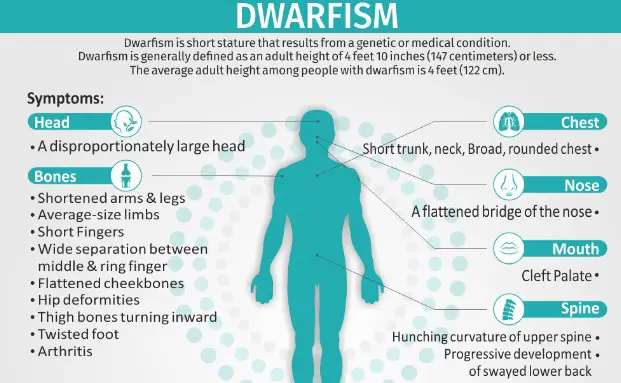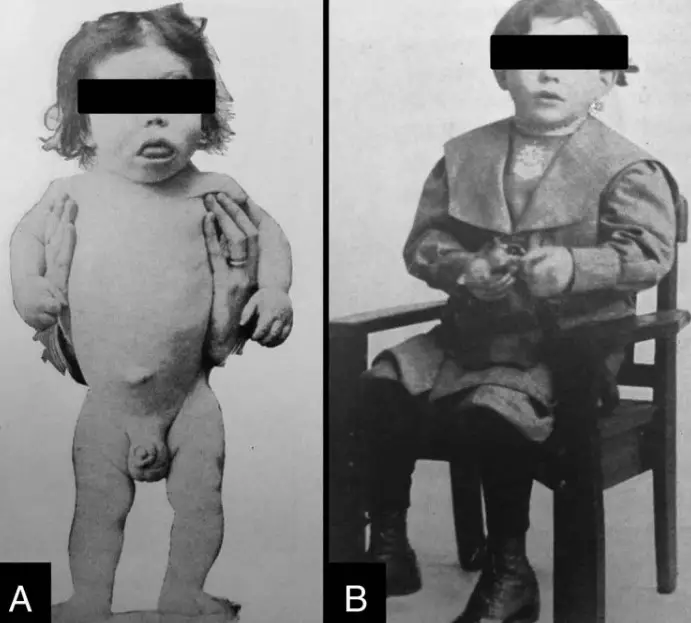Dwarfism and cretinism are two distinct medical conditions that often get intertwined in public discourse, leading to confusion and misunderstandings. While both conditions involve growth issues, their causes, implications, and treatments differ significantly. This distinction is crucial not only for medical professionals but also for the general public to foster a better understanding and empathy towards individuals dealing with these conditions.
Dwarfism is a condition characterized by short stature resulting from genetic or medical factors, typically defined as an adult height of 4 feet 10 inches (147 centimeters) or shorter. Cretinism, on the other hand, is a condition arising from a severe deficiency of thyroid hormone in infancy and early childhood, leading to stunted physical and mental growth. While dwarfism mainly affects physical stature, cretinism impacts overall development, including cognitive abilities.
Addressing these conditions requires a nuanced understanding of their origins, manifestations, and effects on individuals’ lives. Dwarfism is primarily associated with genetic mutations affecting bone growth, whereas cretinism results from hormonal imbalances that disrupt normal development. Recognizing these differences is essential in providing appropriate care, support, and advocacy for affected individuals and their families.

What is Dwarfism?
Definition
Dwarfism is a medical condition characterized by short stature. According to medical standards, an adult height of 4 feet 10 inches (147 centimeters) or shorter qualifies as dwarfism. This condition is not just about being shorter than average; it’s recognized by the medical community based on specific criteria related to growth and development.
Medical Definition and Criteria
The World Health Organization (WHO) and various medical bodies use specific criteria to classify dwarfism. These criteria focus on measurable aspects of growth, often comparing an individual’s height to standardized growth charts. Dwarfism is primarily identified through these comparisons, alongside genetic testing where applicable.
Causes
Genetic Factors
Genetic mutations are the leading cause of dwarfism. The most common type, achondroplasia, affects approximately 1 in 25,000 births. This mutation impacts the growth of bones, particularly in the arms and legs, leading to a disproportionate body shape.
Health Conditions
Other health conditions can also lead to short stature, including hormonal imbalances, malnutrition, and diseases affecting bone growth. These conditions may not always result in dwarfism as defined by medical criteria but can significantly affect growth.
Types
Dwarfism is categorized into two main types: proportionate and disproportionate.
- Proportionate dwarfism occurs when the body parts are in proportion but scaled down. This type is often related to hormonal issues.
- Disproportionate dwarfism involves some body parts being smaller than others, commonly seen in conditions like achondroplasia.
What is Cretinism?
Definition
Cretinism is a condition caused by a severe deficiency of thyroid hormone in newborns and infants. This deficiency can lead to stunted physical and mental development, significantly impacting a child’s growth and cognitive abilities.
Explanation in Medical Terms
In medical terms, cretinism is referred to as congenital hypothyroidism. The thyroid gland’s failure to produce enough thyroid hormone leads to various developmental issues, highlighting the importance of early diagnosis and treatment.
Causes
Iodine Deficiency
Iodine is crucial for thyroid hormone production. A lack of iodine in a pregnant woman’s diet can lead to insufficient thyroid hormone levels in the developing fetus, causing cretinism.
Thyroid Dysfunctions
Other causes include thyroid dysfunctions in the newborn, such as the thyroid gland’s inability to function properly due to genetic or developmental issues.
Consequences
Physical and Cognitive Impacts
Cretinism leads to stunted growth, both physically and mentally. Physically, children may experience delayed growth milestones, while cognitively, they may face challenges with learning and memory.
Key Differences
Height and Growth
When comparing dwarfism and cretinism, one notable difference is in height and growth patterns. Dwarfism primarily affects height with variations in proportionality, whereas cretinism impacts both physical and cognitive development due to thyroid hormone deficiency.
Underlying Causes
The underlying causes of these conditions are markedly different. Dwarfism is often the result of genetic mutations, while cretinism is usually caused by environmental factors like iodine deficiency or thyroid gland issues.
Treatment and Management
Medical Interventions
- For dwarfism, growth hormone therapy and orthopedic surgeries are common treatments to manage symptoms and improve quality of life.
- Cretinism treatment focuses on thyroid hormone replacement therapy to support normal growth and development.
Lifestyle Adaptations
Both conditions may require lifestyle adaptations to assist with daily activities and ensure a high quality of life. This includes tailored educational programs, physical therapy, and community support to help individuals and families manage these conditions effectively.

Diagnosis and Detection
Dwarfism
Screening and Genetic Testing
Diagnosis of dwarfism often begins with physical observation and measuring growth patterns. If a child’s growth rate is significantly below typical standards, healthcare professionals may recommend further screening and genetic testing. This process involves:
- Comparing the child’s growth to standardized growth charts.
- Assessing family history for any genetic patterns of short stature.
- Conducting genetic tests to identify mutations associated with dwarfism, such as those affecting the FGFR3 gene in achondroplasia.
These steps are crucial for early detection, allowing for timely interventions and support.
Cretinism
Neonatal Screening and Thyroid Function Tests
For cretinism, neonatal screening plays a vital role. Within the first few days after birth, newborns undergo screening to check thyroid hormone levels, a process that includes:
- Taking a small blood sample from the baby’s heel.
- Measuring the levels of thyroxine (T4) and thyroid-stimulating hormone (TSH) in the blood.
- If abnormalities are detected, further testing is conducted to confirm the diagnosis.
Early detection through neonatal screening is key to preventing the severe effects of cretinism on growth and development.
Treatment Approaches
For Dwarfism
Growth Hormone Therapy
Growth hormone therapy is a common treatment for some forms of dwarfism, especially when hormone deficiencies are involved. This therapy involves regular injections of synthetic growth hormone to stimulate growth and development. The treatment aims to:
- Increase height in children with growth hormone deficiency.
- Improve overall physical proportion and functionality.
Orthopedic Surgery
For certain types of disproportionate dwarfism, orthopedic surgery may be recommended to correct or improve bone structure. Surgeries might include:
- Limb lengthening, a procedure that gradually increases the length of the arms and/or legs.
- Spinal surgeries to address curvature issues or to relieve pressure on the spinal cord.
These surgical interventions can enhance mobility, comfort, and quality of life.
For Cretinism
Thyroid Hormone Replacement
The primary treatment for cretinism is thyroid hormone replacement therapy. This involves administering synthetic thyroxine (T4) to normalize thyroid hormone levels. Early and consistent treatment can lead to:
- Normal growth and development.
- Improvement in cognitive functions and learning abilities.
Dietary Modifications
In addition to hormone therapy, dietary modifications may be recommended, particularly in areas where iodine deficiency is a common cause of cretinism. Strategies include:
- Using iodized salt in cooking.
- Consuming foods rich in iodine, such as seafood and dairy products.
These dietary changes can help prevent cretinism related to iodine deficiency and support overall thyroid health.
Societal and Psychological Aspects
Public Perception
Myths vs. Facts
Misconceptions about dwarfism and cretinism abound, leading to stigma and misunderstanding. Education is crucial to dispel myths such as:
- Misbelief that dwarfism is always a result of malnutrition.
- Confusion between cretinism and mental incapacity.
By contrasting these myths with facts, we can foster a more informed and empathetic society.
Living with the Conditions
Challenges and Support Systems
Individuals living with dwarfism or cretinism face various challenges, from physical barriers to social stigma. However, strong support systems can significantly improve their quality of life. These include:
- Medical care tailored to their specific needs.
- Educational support to accommodate learning styles or physical needs.
- Community groups that provide a platform for sharing experiences and advice.
Emphasizing the importance of these support systems is essential for helping individuals and their families navigate the complexities of these conditions.
Advocacy and Awareness
Efforts to Improve Understanding and Inclusivity
Advocacy and awareness campaigns play a pivotal role in changing perceptions about dwarfism and cretinism. Efforts include:
- Educational programs that provide accurate information about these conditions.
- Inclusivity initiatives in schools, workplaces, and communities to accommodate individuals with different needs.
- Media representation that portrays individuals with dwarfism or cretinism in a respectful and accurate manner.
Such initiatives are crucial for building a society where everyone, regardless of their physical or developmental conditions, is valued and included.
Frequently Asked Questions
What is the primary cause of dwarfism?
Dwarfism is mainly caused by genetic mutations that affect bone growth and development, leading to shorter stature. The most common form, achondroplasia, is a genetic condition that results in disproportionately short limbs.
Can cretinism be prevented?
Yes, cretinism can often be prevented with early detection and treatment. Adequate iodine intake during pregnancy and early childhood can prevent the thyroid dysfunctions that lead to cretinism. Additionally, newborn screening and prompt thyroid hormone therapy are effective in mitigating the condition’s impact.
Is there a cure for dwarfism?
Currently, there is no cure for dwarfism. Treatment focuses on managing symptoms and complications through interventions such as growth hormone therapy and orthopedic surgery to improve quality of life and functionality.
How is cretinism diagnosed?
Cretinism is diagnosed through newborn screening tests that measure thyroid hormone levels in the blood. Early diagnosis and treatment with thyroid hormone replacement therapy can significantly improve outcomes.
Conclusion
Understanding the difference between dwarfism and cretinism is more than an academic exercise; it’s a step towards fostering a more inclusive and empathetic society. These conditions, while distinct in their causes and impacts, share the commonality of affecting individuals’ lives in profound ways. By demystifying these conditions, we can move towards a future where everyone, regardless of their physical or developmental challenges, is treated with understanding and respect.
In conclusion, it’s essential to approach topics like dwarfism and cretinism with sensitivity and accuracy. By educating ourselves and others, we contribute to breaking down the barriers of misunderstanding and prejudice. This knowledge empowers us to support affected individuals and their families, advocating for their rights and well-being in every aspect of society.
